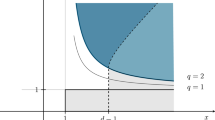Abstract
The so-called diluted-random-cluster model may be viewed as a random-cluster representation of the Blume–Capel model. It has three parameters, a vertex parameter a, an edge parameter p, and a cluster weighting factor q. Stochastic comparisons of measures are developed for the ‘vertex marginal’ when q ∊ [1,2], and the ‘edge marginal’ when q ∊ [1,∞). Taken in conjunction with arguments used earlier for the random-cluster model, these permit a rigorous study of part of the phase diagram of the Blume–Capel model.
Similar content being viewed by others
References
M. Aizenman, D. J. Barsky and R. Fernández, The phase transition in a general class of Ising-type models is sharp. Comm. Math. Phys. 47:343–374 (1987).
M. Aizenman, J. Bricmont and J. L. Lebowitz, Percolation of the minority spins in high dimensional Ising models. J. Statist. Phys. 49:859–865 (1987).
M. Aizenman, J. T. Chayes, L. Chayes and C. M. Newman, Discontinuity of the magnetization in one-dimensional 1/|x , y|2 Ising and Potts models. J. Statist. Phys. 50:1–40 (1988).
M. Aizenman and R. Fernández, On the critical behavior of the magnetization in high-dimensional Ising models. J. Statist. Phys. 44:393–454 (1986).
K. Alexander, The asymmetric random cluster model and comparison of Ising and Potts models. Probab. Th. Rel. Fields 120:395–444 (2001).
I. Benjamini, R. Lyons, Y. Peres and O. Schramm, Uniform spanning forests. Ann. Probab. 29:1–65 (2001).
M. Biskup, C. Borgs, J. Chayes and R. Kotecký, Partition function zeros at first-order phase transitions: Pirogov–Sinai theory. J. Statist. Phys. 116:97–155 (2004).
M. Biskup, L. Chayes and N. Crawford, Mean-field driven first-order phase transitions in systems with long-range interactions. J. Statist. Phys. 122:1139–1193 (2006).
M. Blume, Theory of the first-order magnetic phase change in UO2. Phys. Rev. 141:517–524 (1966).
M. B. Bouabci and C. E. I. Carneiro, Random-cluster representation for the Blume-Capel model. J. Statist. Phys. 100:805–827 (2000).
J. Bricmont and J. Slawny, Phase transitions in systems with a finite number of dominant ground states. J. Statist. Phys. 54:89–161 (1989).
R. M. Burton and M. Keane, Density and uniqueness in percolation. Comm. Math. Phys. 121:501–505 (1989).
H. W. Capel, On the possibility of first-order transitions in Ising systems of triplet ions with zero-field splitting. Physica 32:966–988 (1966).
H. W. Capel, On the possibility of first-order transitions in Ising systems of triplet ions with zero-field splitting. Physica 33:295–331 (1967).
H. W. Capel, On the possibility of first-order transitions in Ising systems of triplet ions with zero-field splitting. Physica 37:423–441 (1967).
L. Chayes and L. Machta, Graphical representations and cluster algorithms, Part I: discrete spin systems. Physica A 239:542–601 (1997).
L. Chayes and L. Machta, Graphical representations and cluster algorithms, II. Physica A 254:477–516 (1998).
E. N. M. Cirillo and E. Olivieri, Metastability and nucleation for the Blume-Capel model. Different mechanisms of transition. J. Statist. Phys. 83:473–554 (1996).
A. Coniglio, C. R. Nappi, F. Peruggi and L. Russo, Percolation points and critical point in the Ising model. J. Phys. A 10:205–218 (1977).
K. J. Falconer, The Geometry of Fractal Sets. (Cambridge University Press, Cambridge, 1985).
R. Fernández, J. Fröhlich and A. D. Sokal, Random Walks, Critical Phenomena, and Triviality in Quantum Field Theory. (Springer, Berlin, 1992).
C. M. Fortuin, P. W. Kasteleyn and J. Ginibre, Correlation inequalities on some partially ordered sets. Comm. Math. Phys. 22:89–103 (1971).
S. Friedli and C.-E. Pfister, On the singularity of the free energy at a first order phase transition. Comm. Math. Phys. 245:69–103 (2004).
A. Gandolfi, M. Keane and L. Russo, On the uniqueness of the infinite occupied cluster in dependent two-dimensional site percolation. Ann. Probab. 16:1147–1157 (1988).
H.-O. Georgii, O. Häggström and C. Maes, The random geometry of equilibrium phases. In Phase Transitions and Critical Phenomena, volume 18, pp. 1–142. (Academic Press, San Diego, CA, 2001).
G. R. Grimmett, The stochastic random-cluster process and the uniqueness of random-cluster measures. Ann. Probab. 23:1461–1510 (1995).
G. R. Grimmett, The random-cluster model. In H. Kesten (ed.), Probability on Discrete Structures, volume 110 of Encyclopaedia of Mathematical Sciences, pp. 73–123. (Springer, Berlin, 2003).
G. R. Grimmett, The Random-Cluster Model. (Springer, Berlin, 2006).
G. R. Grimmett and M. S. T. Piza, Decay of correlations in random-cluster models. Comm. Math. Phys. 189:465–480 (1997).
Y. Higuchi, Coexistence of infinite *-clusters. II. Ising percolation in two dimensions. Prob. Th. Rel. Fields 97:1–33 (1993).
Y. Higuchi, A sharp transition for the two-dimensional Ising percolation. Prob. Theor. Rel. Fields 97:489–514 (1993).
R. Holley, Remarks on the FKG inequalities. Comm. Math. Phys. 36:227–231 (1974).
O. Hryniv and R. Kotecký, Surface tension and Ornstein-Zernike behaviour for the 2d Blume-Capel model. J. Statist. Phys. 106:431–476 (2002).
C.-K. Hu, Correlated percolation and phase transitions in Ising-like spin models. Chin. J. Phys. 32:1–12 (1984).
R. Kotecký and S. Shlosman, First order phase transitions in large entropy lattice systems. Comm. Math. Phys. 83:493–515 (1982).
L. Laanait, A. Messager, S. Miracle-Solé, J. Ruiz and S. Shlosman, Interfaces in the Potts model I: Pirogov-Sinai theory of the Fortuin-Kasteleyn representation. Comm. Math. Phys. 140:81–91 (1991).
J. L. Lebowitz and A. Martin-Löf, On the uniqueness of the equilibrium state for Ising spin systems. Comm. Math. Phys. 25:276–282 (1972).
J. L. Lebowitz and J. L. Monroe, Inequalities for higher order Ising spins and for continuum fluids. Comm. Math. Phys. 28:301–311 (1972).
E. Olivieri and F. Manzo, Dynamical Blume-Capel model: competing metastable states at infinite volume. J. Statist. Phys. 104:1029–1090 (2001).
R. B. Potts, Some generalized order-disorder transformations. Proc. Camb. Phil. Soc. 48:106–109 (1952).
L. Russo, The infinite cluster method in the two-dimensional Ising model. Comm. Math. Phys. 67:251–266 (1979).
R. Schneider, Convex Bodies: The Brunn-Minkowski Theory. (Cambridge University Press, Cambridge, 1993).
R. H. Swendsen and J.-S. Wang, Nonuniversal critical dynamics in Monte Carlo simulation. Phys. Rev. Lett. 58:86–88 (1987).
Author information
Authors and Affiliations
Corresponding author
Additional information
Mathematics Subject Classification (2000): 82B20, 60K35.
Rights and permissions
About this article
Cite this article
Graham, B.T., Grimmett, G.R. Random-Cluster Representation of the Blume–Capel Model. J Stat Phys 125, 283–316 (2006). https://doi.org/10.1007/s10955-006-9135-6
Received:
Accepted:
Published:
Issue Date:
DOI: https://doi.org/10.1007/s10955-006-9135-6




